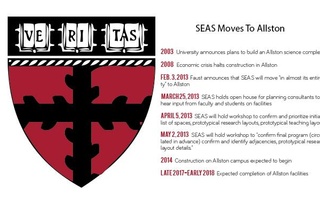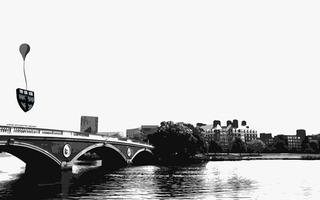UPDATED: October 22, 2014, at 5:10 a.m.
Computer science, biomedical engineering, and mechanical engineering are the three undergraduate teaching areas at the School of Engineering and Applied Sciences whose faculty and facilities are slated to move to Allston in 2019, members of the school’s leadership said this week.
Applied mathematics, applied physics, electrical engineering, and environmental science and engineering, on the other hand, will remain in Cambridge during the so-called first phase of development.
A number of institutes and research centers will also relocate across the river, including the Institute for Applied Computational Science, the Center for Research on Computation and Society, and the Wyss Institute for Biologically Inspired Engineering's Cambridge-based division.
{shortcode-a4ef3afe4d26b5b3dc6a195659a85beadfdcf643}
In total, about two-thirds of SEAS faculty will relocate to the yet-to-be-built Allston campus as a result of this division, according to SEAS spokesperson Paul Karoff. The school currently has about 80 tenure or tenure-track professors and plans to expand that number by about 30 percent.
“Most of the determinations about Allston vs. Cambridge were straightforward,” Karoff wrote in an email.
The decision about who would move and stay was ultimately made by SEAS dean Cherry A. Murray following a discussion at the school’s May faculty meeting, according to Karoff.
He referenced the “unique facilities” based in Cambridge as a reason for determining which sectors relocated, mentioning in particular the Center for Nanoscale Studies used by several different FAS units, including parts of SEAS.
According to Physics professor and Area Dean for Applied Physics Eric Mazur, most physicists work at CNS on an almost daily basis.
“Relocating that facility would be impossible because it’s also being used by the Physics Department, by the Chemistry Department, by a number of even biology departments,” Mazur said, adding that Harvard invested hundreds of millions of dollars in the center.
Professor of atmospheric and environmental science and Area Dean for Environmental Science and Engineering Steven C. Wofsy said that the collaboration between his SEAS area and FAS’s Earth and Planetary Sciences Department constitutes an obstacle to moving.
“Almost everybody is jointly appointed,” he said. “So if EPS doesn’t move it doesn’t make any sense to move our area.”
However, he added that environmental sciences and engineering may move during a second phase of development of the Allston campus in about ten years.
According to Karoff, there is not yet a timeframe or definite plans for this second phase, even though it is a part of Harvard’s institutional master plan in Allston that the Boston Redevelopment Authority approved in 2013.
Read more in University News
Mass. Gen. Eyes Expansion in China; Harvard Not InvolvedRecommended Articles
-
Engineering School To Move Across River, SEAS Faculty Criticize ‘Allston Bomb’The Harvard School of Engineering and Applied Sciences will relocate “in almost its entirety” to University-owned land in North Allston in as few as five years, University President Drew G. Faust told The Crimson Tuesday.
-
Lacking Space, SEAS Plans Allston ExpansionAs the School of Engineering and Applied Sciences awaits its planned move across the river to Allston, the school is in search of short term solutions to immediate problems created by a lack of space.
-
The Right Choice for SEASWe are excited that SEAS will have the opportunity to grow and innovate in a new space across the river, but it will be a pyrrhic victory if SEAS becomes isolated as a result.
-
SEAS Affiliates Discuss Allston Campus PlansSchool of Engineering and Applied Sciences affiliates shared their views on the design of SEAS’ new Allston campus with architectural consultants at an open house event Monday afternoon in the Maxwell Dworkin lobby.
-
 As SEAS Moves to Allston, Administrators Contemplate Schedule Changes
As SEAS Moves to Allston, Administrators Contemplate Schedule Changes -
 SEAS, Crossing Over
SEAS, Crossing Over













